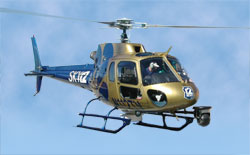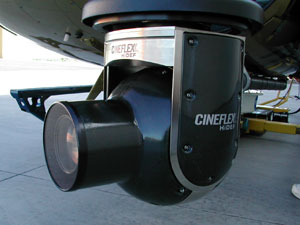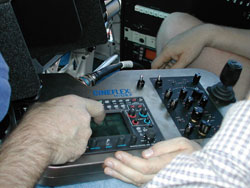
CINEFLEX HI-DEF GYRO STABILIZED CAMERA Reviewed by Lynn French
Our viewers LOVE watching these things unfold on live TV. I will be the first to admit that Phoenix is not a hot bed for Big "J" journalism. People move here to escape being cold and dealing with reality, they don't want either in their newscast. Our viewers love shiny things: car chases with lots of flashing lights, big blazing house fires, sparkling water running in places it should not (I won't tell you how many water main breaks we fly on).
I have worked Wescams for seven years, never tried a Flir, and shot off the shoulder with a gyro zoom for a few years before that. Part of me misses flying with the doors off, hanging by a harness, feeling airspeed against my shoes. Parts of me, my shoulder and back specifically, do not miss the awkward sitting position, the frustration of zooming in for the moment you showed up for and catching a little thermal that bounces the hell out of your shot. I loved the partnership you built with the pilot to give shots a sense of cinematography using the aircraft as the pan and tilt instead of the lens. Now you zoom out, put a little roll in it and it makes crime scenes and real estate look like the opening shot of a film about suburbia. I have a correction to make from the "I'll Fly Away" article, our camera is not serial number 2, it is SN0001. So, as you can guess, we are still working out the bugs. The first time we used the camera was for a car accident (shiny crumpled stuff). If the police officers at the scene saw it on the air that night, they had to feel good...they looked 8 feet tall with 22 inch waists and all of the vehicles involved were Mini Coopers. This is what happens when you squeeze a 16 X 9 image into a 4 X 3 screen without the proper down conversion. Somewhere between the factory and Wysong in Tennessee, folks switched the down conversions from high definition to standard def, back and forth, they switched them one too many times. It is not an easy problem to correct once the helicopter is put together. When Rick, our chief pilot, described what he and the factory rep had to do to fix it, taking the helicopter apart and starting fresh from the air frame sounded like an easier option.
Anyone who works with a Wescam knows the upward looking bounce. If you point the camera too far above the horizon, it starts to jiggle up and down and locks in this mode for a few seconds. This is a maddening feature if you are shooting other aircraft flying parallel or ascending next to you or a wide shot that includes the sky, such as a sunset (which happens to be our most popular shot in Arizona). The Cine-Flex is far more agile when it comes to it's range of view. It can look about 25 degrees above the flat horizon and when it reaches it's limit, it just stops, no bounce. Both systems are pretty equal when it comes to looking straight down... they get equally confused and can turn the image upside down or lock onto it and keep it stable. Both cameras are equal in a few areas. You can control zoom rate, the controls are easy to understand after you work with them a bit, the laptop gets sticky on the bottom on a hot day and welds to your legs if you are wearing shorts. Both do a fine job of holding on a point as you orbit around it and both can make the image look like it lays down if you don't tweak the roll occasionally. Where Wescam has the little thumb controller that looks like a fat canoe to work the roll, Cine-Flex incorporates the roll into the joystick and it operates like a high-end Atari accessory from the '80's, both equally effective and occasionally clumsy. The one advantage of Wescam in this area, you could reverse the roll where you pushed on the low end of the thumb controller to raise the opposite side of the horizon or pushing on one side of the canoe brought that side down and you could increase it's sensitivity to your touch. With the Cine-Flex joystick, you only get the factory setting. There are a few things I miss about the Wescam, namely, the overlay. With Wescam, you can have a lot of important information "supered" onto the monitor that shows your picture: microwave transmitter status, which features are turned on, cross hairs and safety zones. But most importantly, the direction the lens is pointed in relation to the aircraft. Cine-Flex has no overlay what so ever. They have a very "artsy" version of the lens direction inlaid in red lights on the laptop controller. Once you get used to it, it can be functional, but it is not a quick read visually for a brain that is being bombarded with scanner information, air traffic control, the station's off air audio, and the desk calling over the two-way. Usually, I end up stopping for a second, looking out the window for some landmarks and working off those because I can't determine which way the lens is pointing from the picture on the monitor. In a really heated spot news situation, you will find your eyes fatigue a lot quicker doing this versus glancing at the corner of the screen to check the overlay. Here we come to the big bug: the microwave transmitter status. The microwave system is by NSI (not affiliated with Cineflex). The NSI microwave pod used in our system was designed to go on top of live trucks. To install it on our helicopter, they turned it upside down and put it on the belly. Well, the reading it gives you to help your engineering folks tune you in on the ground IS OFF BY 180 DEGREES! I think most of us would agree that we went into television so we would not have to do any complicated math. Every reading the pod gives in relation to the receive site requires that we add 180 unless it is over 180, then we subtract 180. Yeah, carry the two, divide by six, and take the derivative of the logarithm to the "nth power, damn, do I sound like an idiot over the two-way when I am trying to do math in my head. The NSI microwave system was recommended to us because of it's stronger antenna and it also works as a receiver for doing bounce shots. For now, we will have to live with it. If you are considering an NSI system for a helicopter, ask if this has since been fixed. With the bugs come wonderful advancements. The nose mount itself looks cool. It has a carbon fiber covering and is considerably lighter than the other ball camera systems; 67 pounds... I have worked with MII cameras that weighed more. The iris and white balance controls have a wider range than older systems. Rather than the classic 3200K Filter One for nighttime, and three 5600K filters with two neutral densities for daylight, it works on the independent filters where you can dial in varying levels of ND and four different white balance colors (3200, 4300, 5600, 6300). In a place like Phoenix with nuclear sunlight almost every day of the year or somewhere with snow and bright sun, you can get a much nicer iris range with the independent filters and maintain better colors with the various white balances. I will be interested to see how this portion of the system holds up over the years. These are controlled with a touch screen. News photographers are not known for their light touch. If I had to place a bet as to what we will break first, this would be it. As many differences as I see as the operator, where it really counts is with the viewers. Along with the much crisper picture and better colors, it is just so freakin' solid. If you are watching it from home, you will think we have a tripod in the sky. With the purchase of a new helicopter, we did not get better air over Arizona. There are still the same thermals, tail winds and pollution. But in combination with a more powerful aircraft, the camera does an incredible job of taking any vibration out of the tightest shots. With that powerful zoom, as the operator, it is more important than ever to be sensitive to our viewers. Just because I can go on doubler and see the blown out skull of a dude who was found executed in the desert and tell you the time off of his wrist watch does not mean I should, some things are still best done on a wide shot. It will be interesting to see this new camera system mature and evolve over the years in the same way Wescam and Flir have while paving the way for some great innovations. But just once before it gets too hot, I would like to fly with the doors off for old times sake on Car Chase Tuesday. |
|
home | what's new | product reviews | SPOTLIGHT | b-wear | message board | tips | job listings | market info b-roll.net ©1996-2006 Kevin Johnson |
 In Phoenix, we have "Car Chase Tuesday" and "Thunderstorm Thursday". For some reason, the crazies go carjacking on Tuesdays and lead police and the gaggle of TV news helicopters on low speed pursuits through residential areas. On Thursdays we get fast moving weather events that arrive with a huge wall of dust called a "haboob" (that is the correct meteorological term---guess what it looks like?) and drop a little rain in the streets that also serve as the drainage system. The village idiots then drive around in it until they drown their Volkswagens and have to be rescued by redneck angels in jacked-up Ford 150s with tractor tires on custom rims.
In Phoenix, we have "Car Chase Tuesday" and "Thunderstorm Thursday". For some reason, the crazies go carjacking on Tuesdays and lead police and the gaggle of TV news helicopters on low speed pursuits through residential areas. On Thursdays we get fast moving weather events that arrive with a huge wall of dust called a "haboob" (that is the correct meteorological term---guess what it looks like?) and drop a little rain in the streets that also serve as the drainage system. The village idiots then drive around in it until they drown their Volkswagens and have to be rescued by redneck angels in jacked-up Ford 150s with tractor tires on custom rims. In a city that is 40 miles wide and 60 miles long, the only way to bounce from downtown to Scottsdale in a few minutes during rush hour is via helicopter. And as mentioned before on this website, we got a new one! The ol' Sky Pig we traded in actually had a great camera: a standard issue Wescam with the laptop controller and a 90X lens. The new Sky 12 has a Cineflex Hi-Def gyro stabilized camera with a 108X lens. Same principle, a world of differences.
In a city that is 40 miles wide and 60 miles long, the only way to bounce from downtown to Scottsdale in a few minutes during rush hour is via helicopter. And as mentioned before on this website, we got a new one! The ol' Sky Pig we traded in actually had a great camera: a standard issue Wescam with the laptop controller and a 90X lens. The new Sky 12 has a Cineflex Hi-Def gyro stabilized camera with a 108X lens. Same principle, a world of differences. Once the aspect ratio is corrected, the picture is a jaw dropper to say the least. What this camera can do on 1X most cameras can't do with a doubler. The first time it really hit me was when we were floating over a vendor tent fire at a horse show. I got all the regular shots on 1X and then went to the doubler. Being able to read the fire fighters' names on their helmets from 800 feet above quickly solidified my appreciation for the new system. Even when the HDTV signal is down converted, it is still so much clearer than how a standard camera reads the picture. We used to read license plate numbers pretty well from 1000 feet, now we can see if their registration is expired.
Once the aspect ratio is corrected, the picture is a jaw dropper to say the least. What this camera can do on 1X most cameras can't do with a doubler. The first time it really hit me was when we were floating over a vendor tent fire at a horse show. I got all the regular shots on 1X and then went to the doubler. Being able to read the fire fighters' names on their helmets from 800 feet above quickly solidified my appreciation for the new system. Even when the HDTV signal is down converted, it is still so much clearer than how a standard camera reads the picture. We used to read license plate numbers pretty well from 1000 feet, now we can see if their registration is expired.